
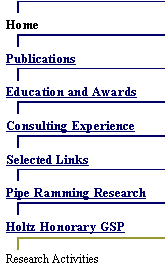
|
Reaction frame systems full scale load tests performed on aggregate piers in Beaumont Clay. |
Shallow Foundations Supported on Aggregate Piers in Stiff Clay |
|
The research program undertaken aims to address the shortcomings of currently accepted performance prediction methods. A field load test program was performed to investigate construction variables of aggregate pier reinforced clay. The load-displacement performance of single and groups of aggregate piers in clay and the improvement in displacement performance over the unreinforced ground were evaluated. A probabilistic site characterization was performed to assist in the interpretation of the load-displacement behavior of the footing load tests. The results of the test program were combined with high-quality load test data found in the literature to form a database of load tests. The database of load tests was used to evaluate existing methods for bearing capacity and displacement performance of footings resting on aggregate pier reinforced clay. New regression-based and semi-empirical methods were developed to predict the ultimate bearing capacity and displacement performance of isolated spread footings. These new methods were found to be superior to those currently available to engineers and contractors. A reliability-based assessment of the regression-based prediction models was performed to characterize reliability indices as a function of load factor, distribution and variability of load, and resistance factor. These new tools will help engineers and contractors asses the short term ultimate bearing capacity and displacement performance of isolated spread footings on aggregate pier reinforced clay. Additional studies in this area are planned. |
|
RESEARCH ACTIVITIES |
LRFD evaluation of augered and driven piles in the pacific northwest |
|
As a consultant, I have developed experience in the design and construction of augered and driven piled foundations. I am working to develop a large database of pile load test information. This information will be assessed for the calibration of pile design methods for use with Load and Resistance Factor Design, allowing the geotechnical risk associated with accepted design methods to be characterized. This exciting work will provide engineering practitioners in the Pacific Northwest with valuable design information that can be readily put to use to serve the infrastructure needs of the region. |
|
Above: Reaction frame used to test a series of 18-inch diameter augercast piles founded in glacially overridden glaciolacustrine Lawton Silts; Seattle, WA. Below: strain gages used in augered piles. |
|
Above: View of the 46 meter tall West MSE Wall at Sea-Tac International Airport. This MSE wall was outfitted with 412 strain gauges installed for the purpose of monitoring construction performance. Below: strain gages used in reinforcement strips. |
Instrumentation and Performance of Very Tall MSE Walls |
|
The construction effort for the third runway and related expansion of the Seattle-Tacoma International Airport (STIA) included the erection of several MSE walls, including the single tier, 17.7 m (58 feet) South MSE wall, the two tier 25.9 m (85 feet) North Wall, and the four tier, 45.7 m (150 feet) tall West MSE wall. These three MSE Walls were instrumented for construction performance monitoring. The performance data provide insight into the behavior and mechanisms of the overall system of MSE technology for particularly tall walls. Several papers are in the works describing the instrumentation and performance of these walls. The performance data will be used to calibrate new design methods and numerical models for the purpose of performing design optimization and developing recommendations for reinforcement spacing, tier offsets, effect of surcharges, and other geotechnical concerns. |

|
Home | Research Activities | Publications | Education | Consulting Experience | Links |
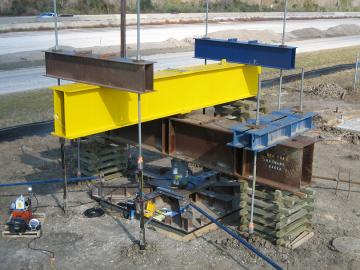
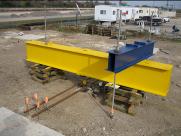
Probabilistic Assessment of helical Anchors in Stiff Clay |
|
While conducting my PhD research, I had the opportunity to observe the behavior of a large number of helical anchors under working and ultimate loads. |
|
Helical Anchor sections used to resist applied tension loads in foundation applications. |

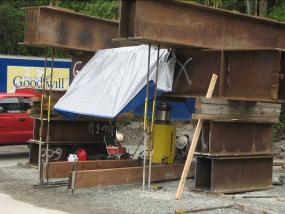
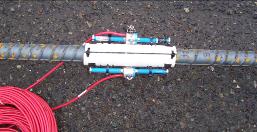

Other research INTERESTS: |
|
Other research activity in initial stages of development include: > Numerical modeling of aggregate pier reinforced clay; > Assessment of spread footings on aggregate pier reinforced cohesionless soil; > Normalized load-displacement behavior of shallow footings in clay; > Prediction of densification using stone column ground improvement; > Random field modeling of Columbia River silt; > Predicting tidal effects in near-shore pumping tests. |


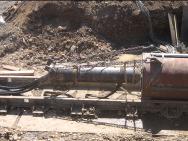
Trenchless Tech: PIPE RAMMING |
|
This research program is focused on understanding the mechanics of pipe ramming for improved design of pipe ramming installations. Click here for more information. |